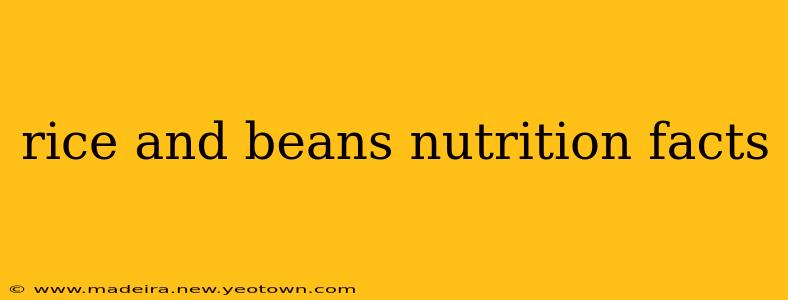Rice and beans. The very words conjure images of cozy kitchens, comforting aromas, and hearty meals shared with loved ones. But beyond the nostalgic appeal, this classic pairing boasts a nutritional profile that's anything but ordinary. It's a dynamic duo, offering a complete protein source and a wealth of essential vitamins and minerals. Let's delve into the fascinating world of rice and beans nutrition, uncovering why this humble dish deserves a place at the forefront of any healthy eating plan.
My grandmother, a culinary maestro in her own right, always emphasized the importance of rice and beans in our family's diet. She'd tell stories of how this dish sustained generations, providing energy and nourishment even in times of scarcity. Looking back, her wisdom rings truer than ever.
What are the Nutritional Benefits of Rice and Beans?
The magic of rice and beans lies in their complementary nature. While rice is a good source of carbohydrates, providing the body with readily available energy, beans are packed with protein and fiber. Together, they form a complete protein, meaning they contain all nine essential amino acids that our bodies cannot produce on their own. This makes rice and beans a fantastic choice for vegetarians, vegans, and anyone looking to boost their protein intake.
Beyond the protein, rice and beans are brimming with essential vitamins and minerals:
- Iron: Crucial for carrying oxygen throughout the body. Beans are particularly rich in this vital nutrient.
- Folate: Essential for cell growth and development, especially important during pregnancy.
- Magnesium: Supports muscle and nerve function, blood sugar control, and blood pressure regulation.
- Potassium: Plays a key role in maintaining healthy blood pressure.
- Fiber: Promotes digestive health, helps regulate blood sugar, and contributes to feelings of fullness.
What Type of Rice and Beans are Best for Nutrition?
The nutritional content of rice and beans can vary depending on the specific type. For example, brown rice generally offers more fiber and nutrients than white rice, while black beans are often higher in protein and antioxidants than other bean varieties. Experimenting with different types allows you to tailor your dish to your preferences and nutritional needs.
Are Rice and Beans a Good Source of Protein?
Yes! This is where the magic truly happens. While neither rice nor beans alone provide a complete protein profile, combining them makes for a powerhouse of essential amino acids. This makes them an excellent protein source for vegetarians and vegans, as well as a valuable addition to any balanced diet.
How Many Calories are in Rice and Beans?
The calorie count of rice and beans varies depending on the serving size, type of rice and beans used, and any added ingredients. However, a typical serving is generally a moderate calorie option, making it a satisfying and healthy meal choice. Always check nutritional labels for specific calorie information.
Are Rice and Beans Good for Weight Loss?
Due to their high fiber content and moderate calorie count, rice and beans can indeed support weight loss efforts. The fiber helps you feel full and satisfied, reducing overall calorie intake. However, moderation is key; portion control is crucial for weight management.
What are the Health Benefits of Eating Rice and Beans Regularly?
Regular consumption of rice and beans offers a range of health benefits, from improved digestion and blood sugar control to reduced risk of chronic diseases like heart disease and type 2 diabetes. The abundance of vitamins, minerals, and fiber contributes to overall well-being and vitality.
Conclusion: A Culinary and Nutritional Triumph
Rice and beans are more than just a simple dish; they're a testament to the power of nutritious and delicious food. This age-old combination offers a complete protein source, a plethora of essential nutrients, and a satisfying culinary experience. So, next time you're looking for a healthy, flavorful, and budget-friendly meal, remember the nutritional power of rice and beans—a legacy of culinary wisdom passed down through generations.

